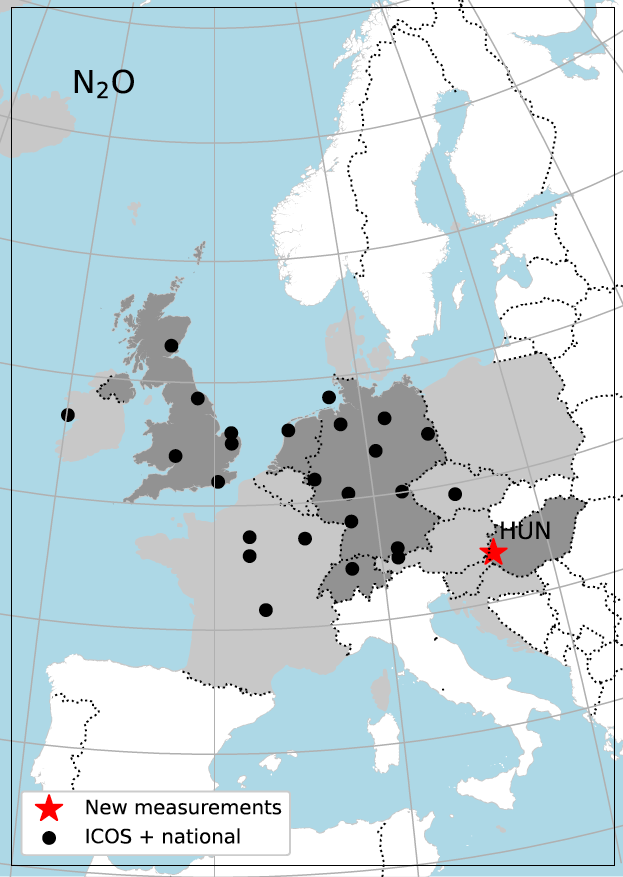Advancing nitrous oxide process models
Objectives and ambitions
Nitrous oxide (N2O) is the third most important anthropogenic greenhouse gas with concentrations rising in the atmosphere and contributing to about 6 % of Europe’s total GHG emissions. Over 75 % of Europe’s emissions originate from the agricultural sector (Petrescu et al., 2021). More than half of agricultural emissions arise from microbial production in managed soils with the amount of fertilizer nitrogen, soil properties and soil environmental conditions controlling the source strength. This interaction of management and soil environmental conditions leads to significant spatial and temporal variability in emissions, which current inventory methods for most European countries neglect as they employ simple emission factor approaches (IPCC Tier 1 and Tier 2 methods). While the capability of Tier 3 (process) models to quantify total N2O emission has been demonstrated, their ability to correctly attribute N2O emission to different soil processes, thus offering a tool to assess abatement strategies, has had little evaluation. Thus, improved Tier 3 models with calibrated processes and time-resolved information, alongside the implementation of N2O inversion systems, will be a significant step towards improving national N2O inventories. PARIS will advance the accuracy of two Tier-3 process models, planned for incorporation by Germany and Switzerland as their inventory N2O models, to simulate N2O fluxes. This will be performed through site-scale model improvement based on N2O isotopic analysis and country-scale assessment through high-resolution atmospheric inverse modelling.
Methodology

As the main objective is to improve reporting of national N2O emissions, PARIS focuses on two complementary approaches for reducing uncertainty in national N2O emission estimates. Within the first approach, we will implement, improve, and apply two process-based biogeochemical models at the site-scale. To assess the quality of the biogeochemical model-derived bottom-up estimate of N2O emissions, we will use our globally unique N2O isotopologue measurement capability to determine the intra-molecular isotopic composition of N2O emitted from agricultural sites. Based on the isotopic tuning of the two models, we will derive temporally and spatially resolved national emissions. The second approach will apply inverse modelling to infer top-down N2O emissions across Europe. It is based on an expanded network of atmospheric measurements, for which we will compile a consistent database of N2O measurements and their uncertainties. To extend the measurement network further east, a new N2O measurement station will be developed in Hegyhátsál, Hungary. Spatially resolved inversions of N2O fluxes at sub-annual scales will be carried out and rigorously intercompared for the period 2017–2025.
Tasks
New atmospheric N2O observations – Expanding the existing N2O network towards the East, the Hungarian tall tower site Hegyhátsál (Hungary) will be extended to include calibrated atmospheric N2O measurements.
Compilation of atmospheric N2O observations for inverse modelling – N2O observations across Europe, including those outside ICOS sites, will be harmonised by cross-comparison of sites / instruments and integration of calibration scales.
Site-scale process model validation – We will identify two to three additional study sites for validation campaigns for relevant cropping systems and perform simulations of isotopes for these new sites and for existing data. Simulation results will be compared to observed isotopic and bulk N2O data to inform improvement of model process description and parameterization.
National-scale prosses model simulations – Based on the improvements to the model performed in the task “Site-scale process model validation”, two biogeochemical models will be run for the periods covered by atmospheric N2O observations.
Top-down nitrous oxide flux estimation – N2O flux estimates will be derived based on the observations collected in the tasks “New atmospheric N2O observations” and “Compilation of atmospheric N2O observations for inverse modelling”. Inversions at sub-annual and sub-national scales of N2O fluxes will be conducted using various inverse modelling approaches.
Comparison of fluxes derived from different methods – Top-down, bottom-up and reported N2O will be compiled for focus countries and these results will be presented annually in an Annex to the National Inventory Report. Discrepancies will be discussed considering best available error estimates for both bottom-up and top-down approaches.





